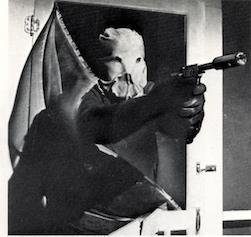THE TOWN THAT DREADED SUNDOWN: The Serial Killer Movie's Downhome Roots
Never underestimate the lure of a true story when you're trying to sell a movie to audiences. The career of Charles B. Pierce offers proof of why this is such a good tactic: he took a Southern variant on the Bigfoot legend and spun it into indie box-office gold in 1972 with The Legend Of Boggy Creek. A few years later he followed the true story template to success once again with a film entitled The Town That Dreaded Sundown - and it found him bringing modern depictions of violence and terror into his old-fashioned style. The Town That Dreaded Sundown takes its inspiration from a string of killings that haunted Texarkana during the first half of 1946. The murderer, dubbed "The Phantom Killer" by the press, attacks couples in secluded locations and spaces out the killings by several weeks to build fear and unease in the public. Local law enforcement calls on Texas Ranger J.D. Morales (Ben Johnson) to head up the manhunt. Morales works with local Deputy Norman Ramsey (Andrew Prine) to hunt for the killer as they theorize about what drives him - but this killer is as elusive and mysterious as he is lethal.The resultin
The Town That Dreaded Sundown takes its inspiration from a string of killings that haunted Texarkana during the first half of 1946. The murderer, dubbed "The Phantom Killer" by the press, attacks couples in secluded locations and spaces out the killings by several weeks to build fear and unease in the public. Local law enforcement calls on Texas Ranger J.D. Morales (Ben Johnson) to head up the manhunt. Morales works with local Deputy Norman Ramsey (Andrew Prine) to hunt for the killer as they theorize about what drives him - but this killer is as elusive and mysterious as he is lethal.The resultin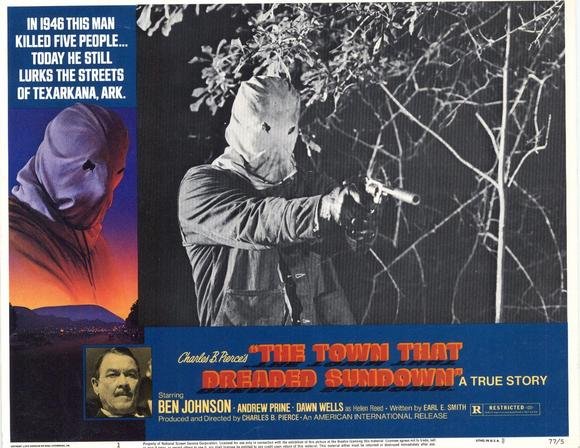 g film is a mixes old-fashioned filmmaking techniques and a modern depiction of violence to disorienting effect. Pierce affects a vintage filmmaking style here: extensive use is made of narration to set up the story (just like The Legend Of Boggy Creek) and Pierce breaks up the story's shocks with broad comic relief. The latter element hasn't aged too well - the comedy bits go on too long and their seeming self-indulgence isn't helped by the fact that Pierce has cast himself as the comic-relief deputy at the center of all these comic scenes. As the film progresses and the tension mounts, these humorous beats really get distracting.
g film is a mixes old-fashioned filmmaking techniques and a modern depiction of violence to disorienting effect. Pierce affects a vintage filmmaking style here: extensive use is made of narration to set up the story (just like The Legend Of Boggy Creek) and Pierce breaks up the story's shocks with broad comic relief. The latter element hasn't aged too well - the comedy bits go on too long and their seeming self-indulgence isn't helped by the fact that Pierce has cast himself as the comic-relief deputy at the center of all these comic scenes. As the film progresses and the tension mounts, these humorous beats really get distracting.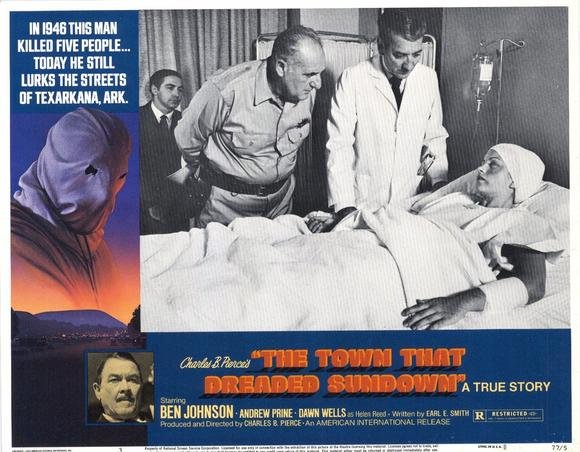 That said, it's worth sticking with The Town That Dreaded Sundown because the majority of the film is quite effective. Pierce is effective at creating a creepy atmosphere, mixing a haunting score from Jaime Mendoza Nava with stylish scope photography from Jim Roberson to create a moody backdrop for the Phantom Killer's reign of terror. Low-key, stoic performances from Johnson and Prine lend the right note of gravitas to the law enforcement element of the story.Most import
That said, it's worth sticking with The Town That Dreaded Sundown because the majority of the film is quite effective. Pierce is effective at creating a creepy atmosphere, mixing a haunting score from Jaime Mendoza Nava with stylish scope photography from Jim Roberson to create a moody backdrop for the Phantom Killer's reign of terror. Low-key, stoic performances from Johnson and Prine lend the right note of gravitas to the law enforcement element of the story.Most import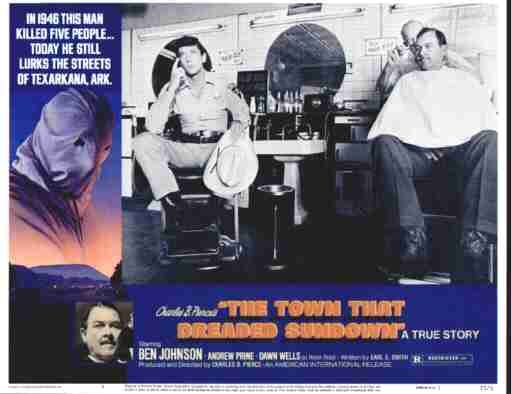 antly, the scenes involving the Phantom Killer stalking his prey are genuinely creepy and unnerving. Pierce drops all the old-fashioned niceties of his filmmaking approach in these moments, with the camera never wavering from the violence and the relentless cruelty of the film's killer.The key scenes in this area are a setpiece where the killer attacks and murders a couple fresh from their prom and a savage sequence where he wounds and chases housewife Helen Reed (Dawn Wells) out of her house and into a cornfield after murdering her husband. The first scene involves an unusual murder method that is famous amongst the film's fans and the second is as brutal
antly, the scenes involving the Phantom Killer stalking his prey are genuinely creepy and unnerving. Pierce drops all the old-fashioned niceties of his filmmaking approach in these moments, with the camera never wavering from the violence and the relentless cruelty of the film's killer.The key scenes in this area are a setpiece where the killer attacks and murders a couple fresh from their prom and a savage sequence where he wounds and chases housewife Helen Reed (Dawn Wells) out of her house and into a cornfield after murdering her husband. The first scene involves an unusual murder method that is famous amongst the film's fans and the second is as brutal 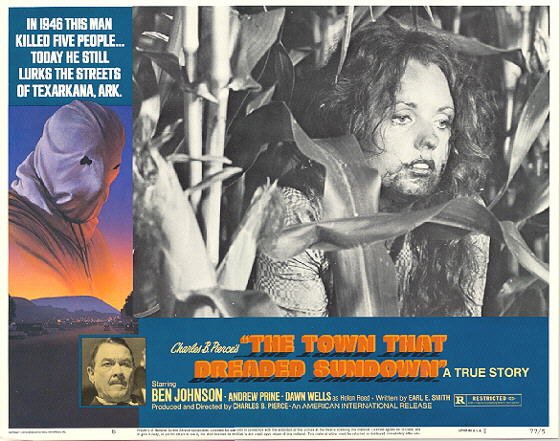 as any stalking scene from The Texas Chainsaw Massacre or The Toolbox Murders, with the effect heightened by the fact that the brutalized victim is played by a former star of Gilligan's Island(!). Along similar lines, the final confrontation between the cops and the killer is handled in a suspenseful, stylish manner: this bit was a fictional creation but gives a satisfying payoff to a story that wouldn't have one otherwise.In short, The Town That Dreaded Sundown remains an effective serial killer docudrama and one of Pierce's most memorable films. Even if you factor in the lapses of humor and the fictionalized elements of the storyline, the film has a raw power and a unique blend of old-fashioned technique and modern shocks that will get under the viewer's skin.
as any stalking scene from The Texas Chainsaw Massacre or The Toolbox Murders, with the effect heightened by the fact that the brutalized victim is played by a former star of Gilligan's Island(!). Along similar lines, the final confrontation between the cops and the killer is handled in a suspenseful, stylish manner: this bit was a fictional creation but gives a satisfying payoff to a story that wouldn't have one otherwise.In short, The Town That Dreaded Sundown remains an effective serial killer docudrama and one of Pierce's most memorable films. Even if you factor in the lapses of humor and the fictionalized elements of the storyline, the film has a raw power and a unique blend of old-fashioned technique and modern shocks that will get under the viewer's skin.


